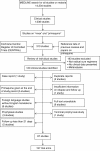Primaquine radical cure of Plasmodium vivax: a critical review of the literature
- PMID: 22900786
- PMCID: PMC3489597
- DOI: 10.1186/1475-2875-11-280
Primaquine radical cure of Plasmodium vivax: a critical review of the literature
Abstract
Background: Primaquine has been the only widely available hypnozoitocidal anti-malarial drug for half a century. Despite this its clinical efficacy is poorly characterized resulting in a lack of consensus over the optimal regimen for the radical cure of Plasmodium vivax.
Methods: Published studies since 1950 of the use of primaquine regimens for preventing P. vivax relapse were reviewed. Data were extracted systematically from available papers. Primaquine regimens were categorized according to the total dose administered: very low (≤2.5 mg/kg), low (>2.5 mg/kg- < 5.0 mg/kg) and high (≥ 5.0 mg/kg). The risk of recurrent infection were summarized across geographical regions and the odds ratios between treatment regimens calculated after stratifying by total treatment dose and duration of study follow up.
Results: Data could be retrieved from 87 clinical trials presenting data in 59,735 patients enrolled into 156 treatment arms, conducted in 20 countries. There was marked heterogeneity in study design, particularly primaquine dosing and duration of follow up. The median rate of recurrence following very low dose of primaquine (n = 44) was 25% (range 0-90%) at 4-6 months, compared to 6.7 % (range 0-59%) following low dose primaquine (n = 82). High dose primaquine regimens were assessed in 28 treatment arms, and were associated with a median recurrence rate of 0% (Range: 0-15%) at one month. In 18 studies with control arms, the effectiveness of a very low dose primaquine regimen was no different from patients who did not receive primaquine (OR = 0.60, 95%CI 0.33-1.09, p = 0.09), whereas for the low dose regimens a significant difference was reported in 50% (6/12) of studies (overall OR = 0.14, 95%CI: 0.06-0.35, p < 0.001). Two studies enrolling 171 patients demonstrated high effectiveness of high dose primaquine compared to a control arm (OR = 0.03 (95%CI: 0.01-0.13); p < 0.0001).
Conclusions: Low dose regimens retain adequate efficacy in some areas, but this is not uniform. The efficacy and safety of pragmatic high dose primaquine regimens needs to be assessed in a range of endemic and geographical locations. Such studies will require a prolonged period of follow up and comparison with control arms to account for confounding factors.
Figures










References
-
- Guerra CA, Howes RE, Patil AP, Gething PW, Van Boeckel TP, Temperley WH, Kabaria CW, Tatem AJ, Manh BH, Elyazar IR, Baird JK, Snow RW, Hay SI. The international limits and population at risk of Plasmodium vivax transmission in 2009. PLoS Negl Trop Dis. 2010;4:e774. doi: 10.1371/journal.pntd.0000774. - DOI - PMC - PubMed
-
- Mendis K, Sina BJ, Marchesini P, Carter R. The neglected burden of Plasmodium vivax malaria. Am J Trop Med Hyg. 2001;64:97–106. - PubMed
-
- Alving AS, Arnold J, Hockwald RS, Clayman CB, Dern RJ, Beutler E, Flanagan CL. Potentiation of the curative action of primaquine in vivax malaria by quinine and chloroquine. J Lab Clin Med. 1955;46:301–306. - PubMed
Publication types
MeSH terms
Substances
Grants and funding
LinkOut - more resources
Full Text Sources

